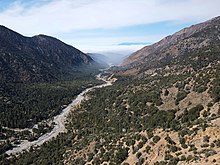
| Mill Creek | |
|---|---|
 | |
 | |
| Location | |
| Country | United States |
| State | California |
| City | Forest Falls |
| Physical characteristics | |
| Source | San Bernardino Mountains |
| • location | San Bernardino National Forest |
| • coordinates | 34°04′36″N 116°50′38″W / 34.07667°N 116.84389°W / 34.07667; -116.84389 |
| • elevation | 8,207 ft (2,501 m) |
| Mouth | Santa Ana River |
| • location | Near Mentone |
| • coordinates | 34°05′27″N 117°07′11″W / 34.09083°N 117.11972°W / 34.09083; -117.11972 |
| • elevation | 1,686 ft (514 m) |
| Length | 17.8 mi (28.6 km) |
| Discharge | |
| • location | Near Yucaipa |
| • average | 38.3 cu ft/s (1.08 m/s) |
| • minimum | 8.04 cu ft/s (0.228 m/s) |
| • maximum | 20,000 cu ft/s (570 m/s) |
Mill Creek is a 17.8-mile-long (28.6 km) stream, originating in the San Bernardino Mountains, in San Bernardino County, California. It is a major tributary of the Santa Ana River. Their confluence occurs just downstream of the upper Santa Ana Canyon mouth. Part of the upper creek flows through San Bernardino National Forest, with the headwaters (High Creek and Mill Creek Jumpoff), being in the San Gorgonio Wilderness.
Mill Creek is in much better condition than the lower portions of the Santa Ana watershed, as its drainage area is less urbanized. However, the creek has three hydroelectric plants owned by Southern California Edison. The first commercial power plant in the United States using three-phase alternating current was the 250 kilowatt Mill Creek No. 1 Hydroelectric Plant, near Redlands, California, in 1893 designed by Almarian Decker.
The streambed is completely dewatered in some places. Also, a levee system was built by the United States Army Corps of Engineers after a severe flood, which degraded the riparian habitat. In addition, the poor conditions downstream interfere with fish migration to the creek.
See also
References
- "Mill Creek". Geographic Names Information System. United States Geological Survey, United States Department of the Interior. 1981-01-19. Retrieved 2016-12-07.
- "Mill Creek Canyon". Geographic Names Information System. United States Geological Survey, United States Department of the Interior. 1981-01-19. Retrieved 2016-12-07.
- ^ U.S. Geological Survey. National Hydrography Dataset high-resolution flowline data. The National Map Archived 2012-03-29 at the Wayback Machine, accessed March 16, 2011
- ^ "USGS Gage #11054001 Mill Creek + Canals near Yucaipa, CA". National Water Information System. U.S. Geological Survey. 1919–1986. Retrieved 2016-12-07.
- http://www.ieeeghn.org/index.php/Milestones:Mill_Creek_No._1_Hydroelectric_Plant,_1893 IEEE Milestones, Mill Creek No. 1 Hydroelectric Plant, retrieved 2012 Jan 4
- Forbes, Shari (2022-03-24). "Redlands electrifies the world". Redlands Community News. Retrieved 2022-03-28.
- University of Southern California: Mill Creek history
- U.S. Geological Survey Geographic Names Information System: Mill Creek
External links
- Historic American Engineering Record (HAER) No. CA-2272, "Mill Creek 2 and 3 Hydroelectric Systems, Mill Creek, Yucaipa, San Bernardino County, CA", 10 photos, 22 data pages, 8 photo caption pages
This San Bernardino County, California–related article is a stub. You can help Misplaced Pages by expanding it. |
This article related to a river in California is a stub. You can help Misplaced Pages by expanding it. |